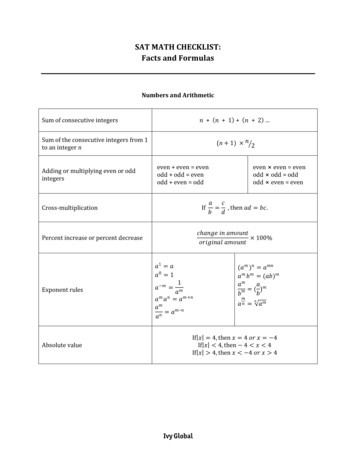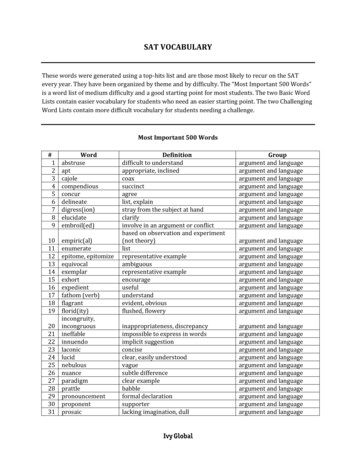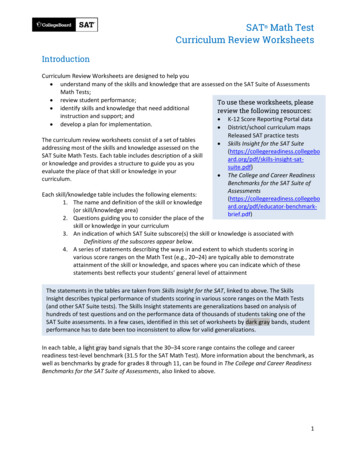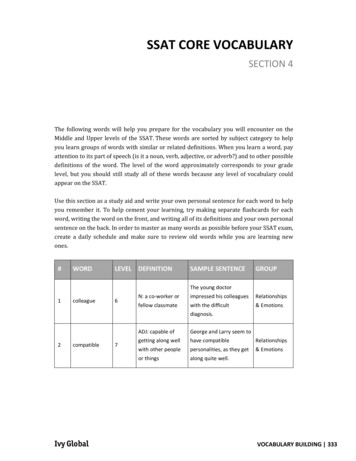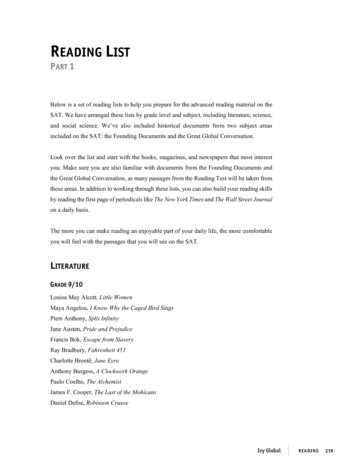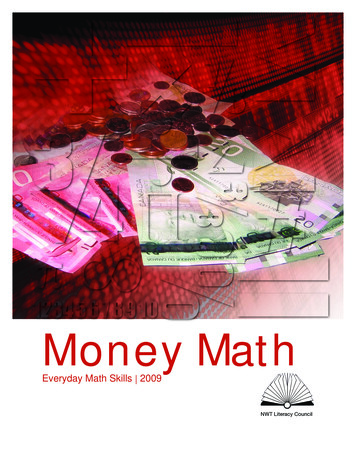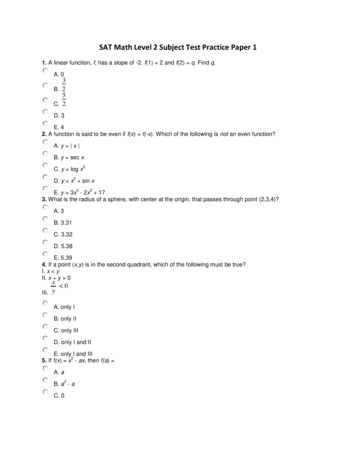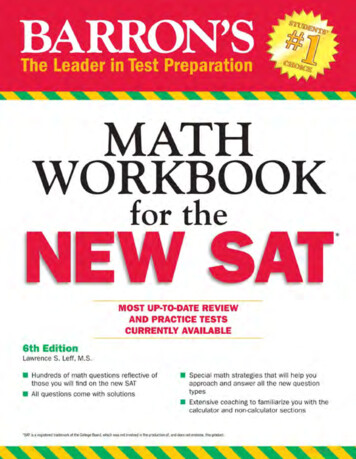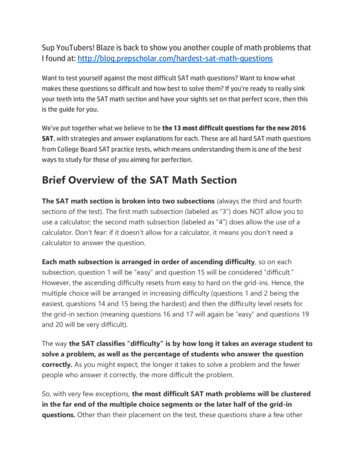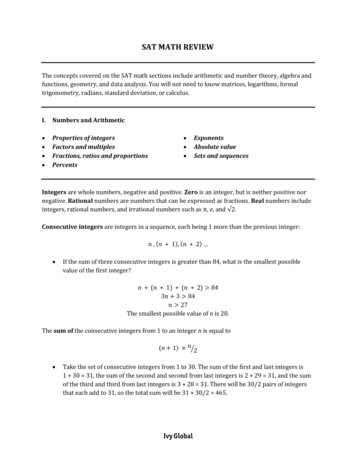
Transcription
SAT MATH REVIEWThe concepts covered on the SAT math sections include arithmetic and number theory, algebra andfunctions, geometry, and data analysis. You will not need to know matrices, logarithms, formaltrigonometry, radians, standard deviation, or calculus.I.Numbers and Arithmetic Properties of integersFactors and multiplesFractions, ratios and proportionsPercents ExponentsAbsolute valueSets and sequencesIntegers are whole numbers, negative and positive. Zero is an integer, but is neither positive nornegative. Rational numbers are numbers that can be expressed as fractions. Real numbers includeintegers, rational numbers, and irrational numbers such as π, e, and 2.Consecutive integers are integers in a sequence, each being 1 more than the previous integer:𝑛, 𝑛 1 , 𝑛 2 If the sum of three consecutive integers is greater than 84, what is the smallest possiblevalue of the first integer?𝑛 (𝑛 1) (𝑛 2) 843𝑛 3 84𝑛 27The smallest possible value of n is 28.The sum of the consecutive integers from 1 to an integer n is equal to(n 1) 𝑛 2 Take the set of consecutive integers from 1 to 30. The sum of the first and last integers is1 30 31, the sum of the second and second from last integers is 2 29 31, and the sumof the third and third from last integers is 3 28 31. There will be 30/2 pairs of integersthat each add to 31, so the total sum will be 31 30/2 465.Ivy Global
Adding or multiplying even or odd integers will result in a sum or product that is predictably evenor odd: even even even even even even odd odd even odd odd odd odd even odd odd even evenAn integer can be divided into a limited set of factors; there are an infinite number of multiplesthat can be divided by a specific integer. An integer with only 2 factors (itself and 1) is a primenumber. 1 is not a prime number, but 2 is.The least common multiple of two integers is the smallest positive integer that is a multiple ofboth integers. The greatest common factor of two integers is the largest integer that is a factor ofboth integers. You can determine both of these by finding the prime factors of each integer. What is the difference between the least common multipleand the greatest common factor of 100 and 80?1005Prime factors of 100: 2 2 5 5Prime factors of 80: 2 2 2 2 58022522100 and 80 share two 2s and one 5. Multiplying these prime factors together gives us theirgreatest common factor: 2 2 5 20.In total, four 2s and two 5s appear in these prime factorizations, excluding repeats.Multiplying these prime factors together gives us their least common multiple: 2 2 2 2 5 5 400.The difference between the LCM and the GCF is 400 – 20 380.A fraction generally expresses a part/whole relationship between two quantities. A ratio generallyexpresses a part/part relationship among two or more quantities. If the ratio of boys to girls in the class is 12 to 17 12:17 12the entire class is 12 17 12291217, then the fraction of boys in.If the ratio of green to blue to red marbles in the jar is 5:4:3, then the fraction of green5marbles in the jar is 5 4 3 512.Ivy Global
A proportion is an equation where two ratios are set equal to each other. Solve proportions bycross-multiplying.𝑎 𝑐If , then 𝑎𝑑 𝑏𝑐.𝑏𝑑 A train has travelled 40 miles in the past 45 minutes. If the train is moving at a constantspeed, what distance will it have travelled after 4 hours?Convert to the same units:Set up a proportion:45 minutes 0.75 hours.40 miles𝑥 miles 0.75 hours4 hoursCross-multiply and solve:40 4 0.75𝑥0.75𝑥 1601𝑥 213 miles3A percent can be represented as a fraction whose denominator is 100 or as a decimal: 75% 75/100 0.75. Solve a percent problem by converting the percent into a fraction and crossmultiplying: 30 is 60% of what number?3060 𝑥1003000 60𝑥, so 𝑥 50Alternatively, you can set up an equation and convert the percent into a decimal. The word ofmeans multiplication: 30 is what percent of 150? 30 𝑥 150, so 𝑥 0.2 20%30 is 60% of what number? 30 0.6𝑥, so 𝑥 50Percent increase or percent decrease is equal to𝑐 𝑎𝑛𝑔𝑒 𝑖𝑛 𝑎𝑚𝑜𝑢𝑛𝑡 100%𝑜𝑟𝑖𝑔𝑖𝑛𝑎𝑙 𝑎𝑚𝑜𝑢𝑛𝑡 The price of apples has decreased from 0.99/lb to 0.79/lb. What is the percent decreasein price?𝑐 𝑎𝑛𝑔𝑒 𝑖𝑛 𝑎𝑚𝑜𝑢𝑛𝑡 0.99 0.79 100% 100% 20.2%𝑜𝑟𝑖𝑔𝑖𝑛𝑎𝑙 𝑎𝑚𝑜𝑢𝑛𝑡 0.99Ivy Global
A book has been discounted 15% and its current price is 12. What was its original price?𝑥 12 100% 15%𝑥𝑥 12 0.15𝑥0.85𝑥 12𝑥 14.12Exponent notation indicates that a number is being multiplied by itself. The number is the baseand the number of times it is being multiplied is the exponent. Exponents follow standard rules:𝑎1 𝑎41 4𝑎0 140 1𝑎 𝑚 1𝑎𝑚4 2 142𝑎𝑚 𝑎𝑛 𝑎𝑚 𝑛42 43 45𝑎𝑚 𝑎𝑚 𝑛𝑎𝑛45(𝑎𝑚 )𝑛 𝑎𝑚𝑛(42 )3 4642𝑎𝑚 𝑏𝑚 (𝑎𝑏)𝑚42 32 (4 3)2𝑚𝑎𝑎𝑚𝑚 ( )𝑏𝑏𝑚𝑎𝑛 𝑛 43424 ( )2332𝑎𝑚445 544𝑥If 52 5𝑎 5𝑏 , then what is x in terms of a and b?𝑥52 5𝑥5𝑎 5𝑏 5𝑎 𝑏5𝑥 5𝑎 𝑏x a bThe absolute value of a number is its distance away from 0 on a number line. The absolute valuewill always be positive.If 𝑥 4, then 𝑥 4 𝑜𝑟 𝑥 4If 𝑥 4, then 4 𝑥 4If 𝑥 4, then 𝑥 4 𝑜𝑟 𝑥 4Ivy Global
Solve: A manufacturer of cereal will discard all boxes weighing less than 28.5 oz and more than31.5 oz. What absolute value equation represents all weights x that will be discarded?𝑥 5 4𝑥 5 4 𝑜𝑟 𝑥 5 4𝑥 9 𝑜𝑟 𝑥 1This means x is 4 units away from 5 in either the positive or negative direction.28.5 oz and 31.5 oz are both 1.5 oz away from 30 oz. If these were the weights that werediscarded, we would write𝑥 30 1.5Test:𝑥 30 1.5 𝑜𝑟 𝑥 30 1.5𝑥 31.5 𝑜𝑟 𝑥 28.5However, the manufacturer will discard all boxes that weigh less than 28.5 oz and more than31.5 oz—that is, those that differ more than 1.5 oz from the standard weight of 30 oz. Ourequation should read𝑥 30 1.5Test:𝑥 30 1.5 𝑜𝑟 𝑥 30 1.5𝑥 31.5 𝑜𝑟 𝑥 28.5A set is an unordered collection of items. These can be numbers, colors, letters, days of the week,other sets, etc. The union of two sets is a set consisting of all of the elements of both sets. Theintersection of two sets is a set consisting of only the shared elements. If A is the set of the first three positive even integers and set B {1, 2, 3, 4}, what is theunion of the two sets? What is the intersection of the two sets?A {2, 4, 6} and B {1, 2, 3, 4}, so their union is {1, 2, 3, 4, 6}. Their intersection is {2, 4}.A sequence is an ordered list of numbers, often following a specific pattern. A sequence can bedefinite or indefinite. In an arithmetic sequence, the next term is created by adding a constant tothe previous term. In a geometric sequence, the next term is created by multiplying a constant tothe previous term. Arithmetic sequence: 2, 6, 10, 14, 18, 22 .Geometric sequence: 3, 12, 48, 192, 768 .You may need to find the sum or average of certain terms in a sequence, or the value of a specificterm in a sequence. To answer any sequence question, always write out at least 5 terms to establishIvy Global
the pattern. You will never be asked to derive the formula for a sequence, but you may need to dosomething of the sort in order to answer the questions. Keep in mind: If a1 is the first term of an arithmetic sequence, d is the common difference between terms,and n is the number of terms, then𝑎𝑛 𝑎1 𝑑(𝑛 – 1) If a1 is the first term of a geometric sequence, r is the common ratio between terms, and n isthe number of terms, then𝑎𝑛 𝑎1 (𝑟)𝑛 1 Each term in a sequence is 3 times the preceding term. If the first term is 2, what is theaverage of the 5th and 7th terms?𝑎7 2 36 1458𝑎5 2 34 162The average of the two terms is1458 162 8102Some sequences are neither arithmetic nor geometric. Establish a pattern, but don’t waste yourtime trying to find an algebraic formula for these! 1, 4, 5, 9, 14, 23, 37: each term is the sum of the previous two terms.4, 6, 9, 3, 4, 6, 9, 3: the terms repeat cyclically. A lane divider in a swimming pool has 77 flags strung in a row. The colours repeat in apattern: red, blue, green, red, blue, green, red, blue, green . If the first flag is red, whatcolour is the last flag?The three colours will repeat themselves 77/3 25.66667 times, or 25 times with tworemainders. Following the pattern, these last two flags will be red and blue, respectively.Thus, the last (77th) flag is blue.II. Algebra and Functions Operations involving polynomialsEquations and systems of equationsProperties of inequalitiesWord problems Ivy GlobalFunctions and their domains, rangesStrange symbolsLinear and quadratic graphsGraph behaviour and translations
Polynomials are algebraic expressions involving numbers and variables. You should already knowhow to factor and multiply polynomials. Keep in mind the difference of squares formula:𝑎2 𝑏2 (𝑎 𝑏)(𝑎 𝑏) If 𝑥 2 𝑦 2 25.6 and 𝑥 𝑦 8, what is the value of 2𝑥 2𝑦?𝑥 2 𝑦 2 𝑥 𝑦 (𝑥 𝑦) 25.68(𝑥 𝑦) 25.6𝑥 𝑦 3.22𝑥 2𝑦 2 𝑥 𝑦 2 3.2 6.4Remember what the question is asking—for this problem, it would have been a waste oftime to solve for x and y individually!You may need to solve single equations and systems of equations. To solve a system of equations,you can isolate a variable in one equation and substitute the resulting expression into the otherequation. Sometimes you can also save time by adding or subtracting two or more equations. If 4 times a number minus a second number is equal to 1, and the sum of the two numbers is9, what is their product?Create a system of equations:4𝑥 𝑦 1𝑥 𝑦 9Add:5𝑥 10Solve:𝑥 2𝑦 9 2 7𝑥𝑦 2 7 14Work with inequalities and systems of inequalities the same way you would work withequations and systems of equations, but keep in mind several key properties. Any operationinvolving positive numbers has no effect on the inequality, but multiplying or dividing by a negativenumber reverses the inequality. If both sides of an inequality are positive or negative, taking theirreciprocal also reverses the inequality.If 𝑎 𝑏, then 𝑎 𝑏If 𝑎 𝑏 and 𝑐 is negative, then 𝑎𝑐 𝑏𝑐 andIvy Global𝑎 𝑏 𝑐 𝑐
If 𝑎 𝑏 and both 𝑎 and 𝑏 are the same sign, then 1 1 𝑎 𝑏If 𝑥 2 𝑦 5 and 𝑦 3, give one possible value for x.𝑥 2 𝑦 5, so 𝑦 5 𝑥 2𝑦 3, so 3 𝑦 5 𝑥 23 5 𝑥2 2 𝑥 22 𝑥2 2 𝑥 21 1𝑥 1, , , 1 2 2You will frequently need to convert word problems into algebraic equations. Look for commonwords and phrases that correspond to mathematical operations:Word/PhraseTranslationSymbolequals addition subtraction-multiplication division at leastinequality at mostinequality is, was, has, will bemore, total, increased by, exceeds, gained,older, farther, greater, sumless, decreased, lost, younger, fewer,differenceof, product, eachfor, per, out of, quotient The total of Jake’s and Amy’s ages is 17. Last year, Amy was twice Jake’s age. How old is Jakenow?Key words: total, last year, and twiceLet j represent Jake’s current age and a represent Amy’s current age:𝑗 𝑎 17Ivy Global
To represent the relationship between their ages last year, subtract 1 from each of theircurrent ages:𝑎 1 2(𝑗 1)Solve for j:𝑎 17 𝑗17 𝑗 1 2(𝑗 1)16 𝑗 2𝑗 218 3𝑗𝑗 6Jake is currently 6 years old. An event has two admission prices: adult tickets are 10 each and student/senior ticketsare 8 each. The ticket office has sold 77 tickets totalling 686. How many adult tickets weresold?Key words: each, totallingLet a represent the number of adult tickets and s represent the number of student/seniortickets:𝑎 𝑠 77To represent total revenue, multiply each type of ticket by its price:10𝑎 8𝑠 686Solve for a:𝑠 77 𝑎10𝑎 8(77 𝑎) 68610𝑎 616 8𝑎 6862𝑎 70𝑎 35There were 35 adult tickets sold.You can often solve a word problem involving rates with the following equation:𝑑𝑖𝑠𝑡𝑎𝑛𝑐𝑒 𝑟𝑎𝑡𝑒 𝑡𝑖𝑚𝑒 An airplane flew from Mississippi to California. On the return trip from California toMississippi, its average speed was reduced by 50 miles per hour and the resulting flight was110longer than the original. What is the airplane’s original average speed from Mississippi toCalifornia?Let d be the distance, r be the airplane’s original speed and t be the time, in hours, of itsflight from Mississippi to California.Ivy Global
𝑑 𝑟 𝑡1For its return trip, over the same distance, its speed is 50mph less and its time is 10 greater:11𝑑 𝑟 50 𝑡10Solve for r:11𝑟 𝑡 𝑟 50 𝑡1011𝑟 (𝑟 50) 1011𝑟 𝑟 55101𝑟 5510𝑟 550The plane's original speed was 550 mph. Adam can paint a house in 6 hours. When Karen comes to work, the two together can painta house in 4 hours. Assuming that both work at a constant rate alone and together, how longdoes it take Karen to paint a house alone?We will use the same equation, but the distance d will represent the number of housespainted.𝑑 𝑟 𝑡Let Adam’s rate be 𝑟𝑎 . He paints 1 house in 6 hours:1 𝑟𝑎 61𝑟𝑎 6Let Karen’s rate be 𝑟𝑘 . Their rate together is (𝑟𝑎 𝑟𝑘 ). Together, they paint the same housein 4 hours:1 𝑟𝑎 𝑟𝑘 41As Adam’s rate is 6, we can solve for 𝑟𝑘 :11 ( 𝑟𝑘 ) 4611 𝑟𝑘 641𝑟𝑘 12Karen’s rate is112houses per hour, so she can paint 1 house in 12 hours.Ivy Global
A function is a rule that associates one set of numbers with another dependent set of numbers. Thefunction 𝑓 𝑥 𝑥 1 tells us that every real number 𝑥 is assigned to the corresponding number𝑥 1. If you are asked to find 𝑓 3 , simply follow the rule connecting 3 to its assigned number:𝑓 3 3 1 4. If 𝑥 3𝑥 2 2𝑥 , what is 𝑓𝑓12 𝑓 1 ?11 322𝑓 1 3 1𝑓 22 2131 1 244 2 1 3 2 1113 𝑓 1 1 244If 𝑓 𝑥 3𝑥 2 2𝑥, what is 𝑓(𝑥 2 )?𝑓 𝑥 2 3(𝑥 2 )2 2(𝑥 2 ) 3𝑥 4 2𝑥 2 If 𝑓 𝑥 3𝑥 2 2𝑥, what is 𝑓(𝑓(2))?𝑓 2 3 22 2 2 12 4 8𝑓 8 3 82 2 8 192 16 176𝑓 𝑓 2 176The domain of a function is the set of all the numbers for which the function is defined—that is, allthe “input” numbers for which the function still wor
SAT MATH REVIEW The concepts covered on the SAT math sections include arithmetic and number theory, algebra and functions, geometry, and data analysis. You will not need to know matrices, logarithms, formal trigonometry, radians, standard deviation, or calculus. I. Numbers and Arithmetic Properties of integers Factors and multiples Fractions, ratios and proportions Percents Exponents
